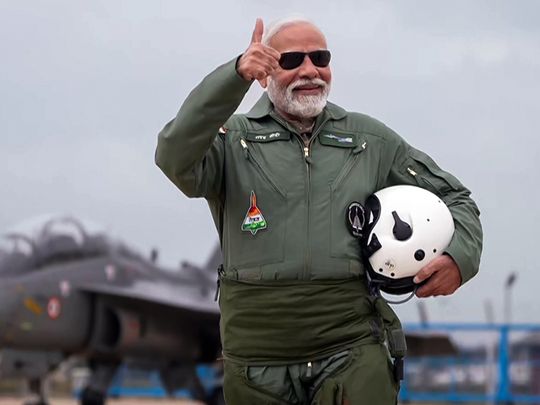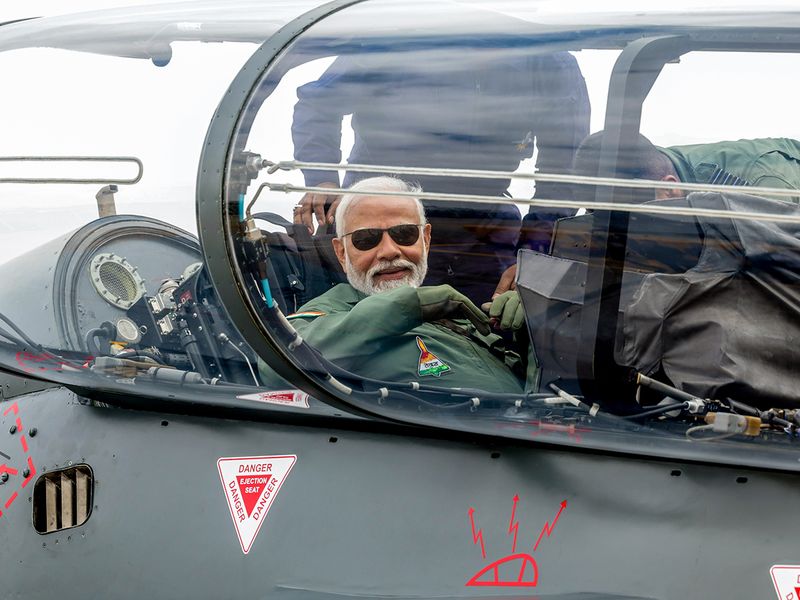
Let us face it. It is not every day that the top leader of a large country undertakes a fighter plane sortie. But that is exactly what India’s Prime Minister, Narendra Modi, did on November 25.
All decked up and kitted out like an Indian Airforce Pilot in a G-suit, complete with aviator glasses, Modi became the first Indian prime minister to lift off in a fighter jet. In the co-pilot’s back seat in the twin-seater Tejas Mk 1A, India’s own “atmanirbhar” (self-reliant) fourth-generation fighter jet last Friday, Modi made the nation proud.
In this historic turn of events, the skies above India witnessed a remarkable moment as Modi took to the cockpit of the indigenously developed Light Combat Aircraft (LCA), Tejas.
This unprecedented event marked a significant milestone in the country’s aerospace achievements and symbolised the Prime Minister’s commitment to promoting indigenous technology and bolstering national defence capabilities.
Bolstering confidence
The image of India’s popular prime minister donning a flight suit and taking control of a fighter jet sent ripples of pride and enthusiasm throughout the nation. Such high-profile engagements not only boost the morale of the defence forces but also instill a sense of national pride among the citizens. The event became a source of inspiration for young minds aspiring to contribute to the fields of science, technology, and defence.
The sortie, undertaken at Bengaluru’s Domestically Aircraft Systems Testing Establishment, successfully demonstrated the all-weather, multiple capability, indigenously designed and produced lightweight jet, Tejas. Manufactured by the Bengaluru-based Hindustan Aeronautics Ltd (HAL), Tejas, with the PM on board for its inaugural launch, marks India’s impressive foray into the Light Combat Aircraft (LCA) fighter jet category.
Modi was quick to flag India’s achievement on X: “Successfully completed a sortie on the Tejas. The experience was incredibly enriching, significantly bolstering my confidence in our country’s indigenous capabilities, and leaving me with a renewed sense of pride and optimism about our national potential.”
The Indian Airforce also seconded the PM. It declared: “With an amalgamation of contemporary concepts and technologies such as quadruplex fly-by-wire flight control, carefree manoeuvring, advanced glass cockpit, integrated digital avionics systems and advanced composite materials for the airframe, it is a state-of-the-art aircraft.”

India’s technological prowess
Coming to its specs, Tejas, a fourth-generation light combat aircraft, boasts advanced avionics, a glass cockpit, and a high level of maneuverability. Its successful development and induction into the Indian Air Force has positioned India among the elite nations capable of designing and manufacturing cutting-edge fighter aircraft. The integration of indigenous technology, including the Kaveri engine and sophisticated radar systems, showcases India’s strides in the aerospace sector.
Yes, carping critics were quick to point out, the engine that drives Tejas is manufactured by General Electric. Yes, the on-and-off project took some 27 years since its inception to reach this take-off. And, of course, the opposition parties passed some disparaging and derogatory remarks, but so what? With the determination and backing showing by the Modi administration, the future promises to be neither as tardy nor hobbled with hitches as the past.
As if to underscore this resolve, the Indian government almost immediately placed a whopping Rs36,468 crore (about $4.3 billion) order for 83 more LCAs, with HAL expected to deliver as early as February 2024. An additional Rs9000 crores ($1.1 billion) have been allocated for the more advanced Tejas Mk 2.
This will add to the two already active and operational Tejas Squadrons 45 and 18 of the IAF. The transfer of jet engine technology from GE, we may recall, was top on the PM’s agenda during his June 2023 state visit to the US.
Tejas, designed and developed by the Aeronautical Development Agency (ADA) and manufactured by Hindustan Aeronautics Limited (HAL), has been a flagship project in India’s pursuit of self-reliance in defence technology.
The state-of-the-art multi-role fighter jet has undergone rigorous testing phases, demonstrating its capabilities in various combat scenarios. Prime Minister Modi’s decision to fly in the Tejas underscores the confidence in the aircraft’s engineering and showcases India’s technological prowess on the global stage.
The Tejas sortie was not merely a symbolic gesture but carried profound implications for India’s defence narrative. With Tejas, India has entered the coveted club of fourth-generation jet fighter makers.
Only the United States and China, which already possess and produce fifth-generation jet fighters, are ahead.
A defining moment
Modi’s sortie served as a powerful statement on the government’s commitment to fostering indigenous defence capabilities and reducing dependence on foreign suppliers. Additionally, the Prime Minister’s active participation in such a mission conveyed a strong message of leadership and trust in the capabilities of the country’s defence establishment.
The project faced numerous challenges during its development, ranging from technological hurdles to budgetary constraints. Technology transfer blockage, rather than backing, was the major hurdle.
However, the persistence of India’s scientific and engineering community, coupled with the government’s unwavering support, enabled the successful realisation of the project. Modi’s Tejas sortie celebrated not only the triumphs of the aircraft but also the collective efforts of the scientists, engineers, and policymakers who overcame adversities to make it a reality.
Beyond the aerospace and defence domains, Modi’s Tejas sortie carried political significance, especially with five state elections going to the polls in November and the upcoming general elections next year. The sortie showcased a leader willing to lead from the front, demonstrating a hands-on approach to critical national matters.
The Prime Minister’s personal involvement in defence matters underscored the government’s commitment to ensuring the security and sovereignty of the nation, not to speak of international recognition and growing influence.
As India continues to strive for excellence and self-reliance in defence technology, the Tejas sortie is sure to stand out. It will be remembered as a defining moment in India’s aerospace history.







